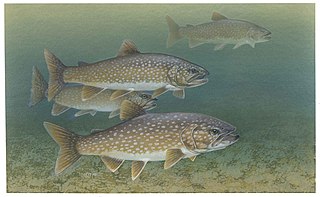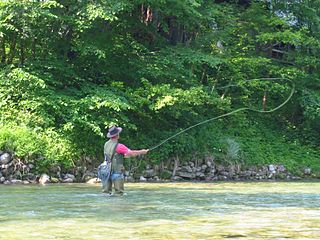
Trout is the common name for a number of species of freshwater fish belonging to the genera Oncorhynchus, Salmo and Salvelinus, all of the subfamily Salmoninae of the family Salmonidae. The word trout is also used as part of the name of some non-salmonid fish such as Cynoscion nebulosus, the spotted seatrout or speckled trout.

Lake trout is a freshwater char living mainly in lakes in northern North America. Other names for it include mackinaw, namaycush,lake char (or charr), touladi, togue, and grey trout. In Lake Superior, it can also be variously known as siscowet, paperbelly and lean. The lake trout is prized both as a game fish and as a food fish. Those caught with dark coloration may be called mud hens.

Fly fishing is an angling method in which an artificial "fly" is used to catch fish. The fly is cast using a fly rod, reel, and specialized weighted line. Casting a nearly weightless fly or "lure" requires casting techniques significantly different from other forms of casting. Fly fishermen use hand tied flies that resemble natural invertebrates, baitfish, other food organisms, or "lures" to provoke the fish to strike.

The brown trout is a European species of salmonid fish that has been widely introduced into suitable environments globally. It includes both purely freshwater populations, referred to as the riverine ecotype, Salmo trutta morpha fario, and a lacustrine ecotype, S. trutta morpha lacustris, also called the lake trout, as well as anadromous forms known as the sea trout, S. trutta morpha trutta. The latter migrates to the oceans for much of its life and returns to fresh water only to spawn. Sea trout in the Ireland and Britain have many regional names: sewin in Wales, finnock in Scotland, peal in the West Country, mort in North West England, and white trout in Ireland.
The bull trout is a char of the family Salmonidae native to northwestern North America. Historically, S. confluentus has been known as the "Dolly Varden", but was reclassified as a separate species in 1980. Bull trout are listed as a threatened species under the U.S. Endangered Species Act (1998) and as vulnerable on the IUCN Red List of Threatened Species.

The rainbow trout is a trout and species of salmonid native to cold-water tributaries of the Pacific Ocean in Asia and North America. The steelhead is an anadromous (sea-run) form of the coastal rainbow trout(O. m. irideus) or Columbia River redband trout (O. m. gairdneri) that usually returns to fresh water to spawn after living two to three years in the ocean. Freshwater forms that have been introduced into the Great Lakes and migrate into tributaries to spawn are also called steelhead.

The brook trout is a species of freshwater fish in the char genus Salvelinus of the salmon family Salmonidae. It is native to Eastern North America in the United States and Canada, but has been introduced elsewhere in North America, as well as to Iceland, Europe, and Asia. In parts of its range, it is also known as the eastern brook trout, speckled trout, brook charr, squaretail, or mud trout, among others. A potamodromous population in Lake Superior, as well as an anadromous population in Maine, is known as coaster trout or, simply, as coasters. The brook trout is the state fish of nine U.S. states: Michigan, New Hampshire, New Jersey, New York, North Carolina, Pennsylvania, Vermont, Virginia, and West Virginia, and the Provincial Fish of Nova Scotia in Canada.

The cutthroat trout(Oncorhynchus clarkii) is a fish species of the family Salmonidae native to cold-water tributaries of the Pacific Ocean, Rocky Mountains, and Great Basin in North America. As a member of the genus Oncorhynchus, it is one of the Pacific trout, a group that includes the widely distributed rainbow trout. Cutthroat trout are popular gamefish, especially among anglers who enjoy fly fishing. The common name "cutthroat" refers to the distinctive red coloration on the underside of the lower jaw. The specific name clarkii was given to honor explorer William Clark, coleader of the Lewis and Clark Expedition.

Lake Cumberland is a reservoir in Clinton, Laurel, McCreary, Pulaski, Russell, and Wayne counties in Kentucky. The primary reasons for its construction were a means for flood control and the production of hydroelectric power. Its shoreline measures 1,255 miles (2,020 km) and the lake covers 65,530 acres (265 km2) at the maximum power pool elevation. The reservoir ranks 9th in the U.S. in size, with a capacity of 6,100,000 acre feet (7.5 km3) of water, enough to cover the entire Commonwealth of Kentucky with 3 inches (76 mm) of water. The main lake is 101 miles (163 km) long and over one mile (1.6 km) across at its widest point.

Creelsboro is a ghost town in Russell County, Kentucky, United States. The historic town was thriving some sixteen years before Russell County was formed. It was named for Elijah Creel, an early settler, and was at one time the busiest river port on the Cumberland River between Nashville, Tennessee, and Burnside, Kentucky. The town hosted a bank, school, three stores and a building that provided lodging for steam boat passengers. Creelsboro was a major trade center along the Cumberland River in the 19th century, although its actual population was only about 50. With the construction of the Wolf Creek Dam, traffic from steamboats and other vessels greatly decreased. Creelsboro's current population primarily are involved in agriculture. Many tourists visit the area to access the Cumberland River for trout fishing and other recreational boating activities.

The Seal of the Commonwealth of Kentucky was adopted in December 1792. Since that time, it has undergone several revisions. The current seal depicts two men, one in buckskin, and the other in more formal dress. The men are facing each other and clasping hands. The outer ring of the seal is adorned with the words "Commonwealth of Kentucky", and within the inner circle is the state motto "United we stand, divided we fall." The official colors of the seal are blue and gold. A version of the seal appears on the flag of Kentucky.

Paul Howard "Dizzy" Trout was an American Major League Baseball pitcher with the Detroit Tigers, Boston Red Sox and the Baltimore Orioles between 1939 and 1957. Trout batted and threw right-handed
Kentucky Alleyne Provincial Park is a provincial park in British Columbia, Canada.
Trout is the common name given to a number of species of freshwater fish.

The Golden Trout Wilderness is a federally designated wilderness area in the Sierra Nevada, in Tulare County and Inyo County, California. It is located 40 miles (64 km) east of Porterville, California within Inyo National Forest and Sequoia National Forest.

Dan Bailey was a fly-shop owner, innovative fly developer and staunch Western conservationist. Born on a farm near Russellville, Kentucky, Bailey is best known for the fly shop he established in Livingston, Montana in 1938. Dan Bailey's Fly Shop is still in business today, operated by his son John at 209 West Park Street.

Paint Creek is a 20.1-mile-long (32.3 km) tributary of the Levisa Fork in Johnson County, Kentucky. The stream is formed at the confluence of the Little Paint and Open Fork creeks. It is named for the colorful Adena Indian ideographs that were painted on white birch trees and rocks that once lined the stream.

Michael Nelson Trout is an American professional baseball center fielder for the Los Angeles Angels of Major League Baseball (MLB). Trout is a seven-time MLB All-Star, received the American League (AL) Most Valuable Player (MVP) award in 2014 and 2016, and is a six-time winner of the Silver Slugger Award. Trout is nicknamed "The Millville Meteor."

Cranks is an unincorporated community in southeastern Harlan County, Kentucky, United States, near the Virginia state line. Elevation ranges from 1,683 to 2,933 feet above sea level. U.S. Route 421 is the main route of travel through this community.
Trout Brook, also called Ball Brook, is a cold water tributary of the Quinapoxet River located in Holden, Massachusetts. Trout Brook is stocked with trout each spring by the Massachusetts Fisheries and Wildlife Division. As the Quinapoxet River is part of the water supply for Worcester, Massachusetts, both the Quinapoxet and all of its major tributaries including Trout Brook are monitored by the USGS for water quality.





















